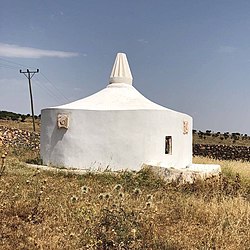Place:List of Yazidi settlements
The following is a list of Yazidi settlements in Iraq, Syria and Turkey, including both current and historical Yazidi settlements. Historically, Yazidis lived primarily in Iraq, Turkey, and Syria. However, events since the end of the 20th century have resulted in considerable demographic shifts in these areas as well as mass emigration.[1] Today, the majority of the Yazidi population lives in Iraq and are particularly concentrated in the Nineveh Plains and Sinjar areas in the Nineveh Province in northern Iraq.[2][3] In the 19th century, an autonomous Yazidi principality existed in the Ottoman Empire and was named "Êzîdxan" ("Land of the Yazidis" in English[4]). The principality was in the Redwan region (north of Cizir)[5] however, today "Êzîdxan" has an ambiguous meaning as the area has not been defined geographically. Despite this, two Yazidi militias in Iraq are named: the Êzîdxan Protection Force and the Êzîdxan Women's Units (an all-female militia offshoot of the Sinjar Resistance Units).[6][7]
Iraq
Turkey
Syria
See also
- Genocide of Yazidis by ISIL
- Sinjar massacre
- Sinjar Alliance
References
- ↑ Garnik S. Asatrian, Victoria Arakelova (2014). The Religion of the Peacock Angel: The Yezidis and Their Spirit World. ISBN 978-1317544289. https://books.google.com/?id=y1RsBAAAQBAJ&pg=PT8&dq=#v=onepage&q=&f=false. Retrieved 17 May 2019.
- ↑ Allison, Christine (2004-02-20). "Yazidis i: General". Encyclopædia Iranica. http://www.iranicaonline.org/articles/yazidis-i-general-1.
- ↑ "Question of the Frontier Between Turkey and Iraq". Geneva: League of Nations. 20 August 1925. p. 49. http://biblio-archive.unog.ch/Dateien/CouncilMSD/C-400-M-147-1925-VII_BI.pdf.
- ↑ Turgut, Lokman (2010) (in de). Mündliche Literatur der Kurden in den Regionen Botan und Hekarî. Logos Verlag Berlin GmbH. ISBN 9783832527273. https://books.google.com/books?id=BZ3HUILlfuQC&pg=PA161&dq=%C3%8Az%C3%AEdxan#v=onepage&q&f=false.
- ↑ Turgut, Lokman (2010) (in German). Mündliche Literatur der Kurden in den Regionen Botan und Hekarî. Logos Verlag Berlin GmbH. pp. 160–161. ISBN 9783832527273. https://books.google.com/?id=BZ3HUILlfuQC&dq=&q=#v=snippet&q=Mirza%20Axa%20Seid%20Beg%20Ezidxan&f=false.
- ↑ "ANF - Ajansa Nûçeyan a Firatê". http://anfenglish.com/women/ypj-shengal-changes-its-name-to-yje.
- ↑ "HPŞ benennt sich in HPÊ um: Hêza Parastina Êzîdxan – ÊzîdîPress". 2015-11-17. http://ezidipress.com/blog/hps-benennt-sich-in-hpe-um-heza-parastina-ezidxan/.
- ↑ Furlani, Giuseppe (June 1937). "The Yezidi Villages in Northern Iraq". The Journal of the Royal Asiatic Society of Great Britain and Ireland (Cambridge University Press) 3 (3): 483–491.
- ↑ Rohat Cebe, Ersoy Soydan (in Turkish). Batman Yezidis and Yezidis Oral Tradition. Batman University. pp. 1143–1152. https://www.academia.edu/37741530. Retrieved 9 June 2019.
- ↑ Muammer Ulutürk (2013) (in Turkish). Etno-Dinsel Bir Topluluk Olan Ezidilerin Batman ve Çevresindeki Son Yerleşim Yerleri ve Nüfusları Üzerine. 8. p. 841–848. doi:10.7827/TurkishStudies.4562. http://www.acarindex.com/dosyalar/makale/acarindex-1423932879.pdf. Retrieved 9 June 2019.
- ↑ (in Turkish) İnsan Hakları Batman Platformu, Batman'daki sığınmacı ve mültecilere ilişkin gözlem ve tespit raporu. Insan Hakları Derneği Batman. 3 March 2015. pp. 1–24. http://web2.e-baro.web.tr/uploads/72/resimler/haberler/multeci%20son/raporson.pdf. Retrieved 9 June 2019.
- ↑ Sebastian Maisel (2014). Yezidis in Syria: Identity Building among a Double Minority. Lexington Books. p. 19. ISBN 9780739177754.





